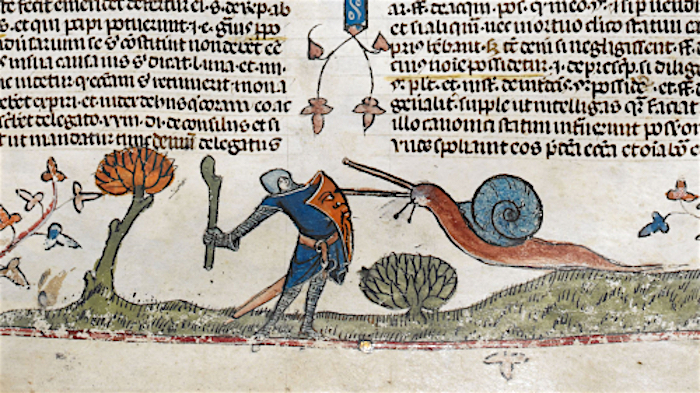
As much as you may enjoy a night in with a book, you might not look so eagerly forward to it if that book comprised 314 folios of 1,971 papal letters and other documents relating to ecclesiastical law, all from the thirteenth century. Indeed, even many specialists in the field would hesitate to take on the challenge of such a manuscript in full. But what if we told you it comes with illustrations of demons running amok, knights battling snails, killer rabbits and other animals taking their revenge on humanity, a dead ringer for Yoda, and the penitent harlot Thäis?

These are just a few of the characters that grace the pages of the Smithfield Decretals, the most visually notable of all extant copies of the Decretales of Pope Gregory IX. When it was originally published as an already-illuminated manuscript in the 1230s, writes Spencer McDaniel at Tales of Times Forgotten, “the margins of the text were deliberately left blank by the original French scribes so that future owners of the text could add their own notes and annotations.” Thus “the manuscript would have originally had a lot of blank space in it, especially in the margins.”

“At some point before around 1340, however, the Smithfield Decretals fell into the possession of someone in eastern England, probably in London, who paid a group of illustrators to add even more extensive illustrations to the text.”
They “drew elaborate borders and illustrations on every page of the manuscript, nearly completely filling up all the margins,” adhering to the contemporary “trend among manuscript illustrators in eastern England for drawing ‘drolleries,’ which are bizarre, absurd, and humorous marginal illustrations.”

Bearing no direct relation to the text of the Decretals, some of these elaborate works of fourteenth-century marginalia appear to tell stories of their own. “These tales have analogues in a dizzying variety of textual and visual sources, including the bible, hagiography, romance, preachers’ exempla, and fabliau” (a humorous and risqué form of early French poetry), writes Alixe Bovey at the British Library’s medieval manuscripts blog. “Some of the narratives have no surviving literary analogues; others constitute isolated visual renditions of once-popular tales.”

If you view the Smithfield Decretals’ illustrations here or in the British Library’s digitization at the Internet Archive, you’ll also see the medieval satirical impulse at work. Take the aforementioned, by now much-circulated “Yoda,” who, as McDaniel writes, “is probably supposed to be a representation of the Devil as a professor of canon law.” It seems that “legal scholars in Middle Ages had a similar reputation to lawyers today; they were seen as slimy, dishonest, and more interested in personal gain than in justice.” They might have been good for a cryptic turn of phrase, but those in need of benevolently dispensed wisdom would have done better to ask elsewhere.

Related content:
Why Knights Fought Snails in Illuminated Medieval Manuscripts
Why Butt Trumpets & Other Bizarre Images Appeared in Illuminated Medieval Manuscripts
Make Your Own Medieval Memes with a New Tool from the Dutch National Library
Based in Seoul, Colin Marshall writes and broadcasts on cities, language, and culture. His projects include the Substack newsletter Books on Cities and the book The Stateless City: a Walk through 21st-Century Los Angeles. Follow him on the social network formerly known as Twitter at @colinmarshall.


Monty Python was Here.
Your father smelled of elderberry wine,